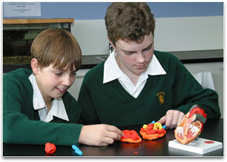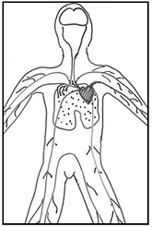Contrasting student and scientific views

Student everyday experience
Students will have a variety of ideas about the circulatory system and its relationship to the body as a whole system. They tend to focus on different parts of the system, such as the heart being a pump rather than it being an organ with its own requirements (i.e. its structure as a muscle and its need for nutrients in order to act as a muscle). Students often know that the heart pumps blood, however are unaware of the components of the blood, other than red blood cells.
Research: Lewis (1999), Loughran, Berry & Mulhall (2004)
Students may be confused about how the blood moves around the body. Rather than it being contained in blood vessels, they may think of it somehow just washing around inside the body, which also raises confusion about how blood and the circulatory system relate to the whole body as a system. This confusion is reasonable given their experiences that blood emerges from any part of the body when they cut themselves. Students who do not have a sense of blood travelling in blood vessels may not recognise that blood flows in only one direction along these vessels.
Research: Lewis (1999), Loughran, Berry & Mulhall (2004)
Although some students have an understanding of blood vessels they often see arteries and veins as similar structures that contain different things. This view is supported by the images they may have seen in books, where blood in veins is usually coloured blue, and that in arteries is coloured red .
Research: Lewis (1999)
The idea of the body producing ‘waste’ is often only connected with the digestive system so waste in the form of gases and ions carried in the blood are seldom identified.
Research: Loughran, Berry & Mulhall (2004)
Students are likely to know that blood has some role in the transportation of oxygen, but there is often confusion about the detail of this idea.
Research: Lewis (1999)
Because of popular lifestyle television shows and the media, students are likely to be aware of some of the effects of lifestyle on the health of a person’s heart but unclear how this is linked to the body as a whole system. For example, students are unaware of the causes of coronary heart disease.
Research: Lewis (1999)
Scientific view
The circulatory system is the transport system of the body and provides the means by which materials are transported around the body. Within the system, the blood is the transport medium and is confined to tubular canals (therefore it is a closed system). The heart is the pump that moves the blood. This system transports many things including oxygen, hormones and nutrients to all cells in the body and carries away waste products.
This closed system consists of a network of blood vessels extending to all parts of the body, as well as the heart acting as the pump for the system. There are three types of blood vessels (tubular canals) that carry the blood throughout the body: arteries, veins and capillaries. All are different in structure and function.
Blood is complex in nature consisting of cells, cell fragments, liquid plasma and dissolved substances and the major component, water.
Exchange occurs between the circulatory system and other systems. For example, the digestive system exchanges the products of digestion; the respiratory system exchanges oxygen and carbon dioxide; the renal system exchanges metabolic waste and the endocrine system exchanges hormones. All these body systems work together to create one big system – the human body.
Research: Loughran, Berry & Mulhall (2004)
Critical teaching ideas
- The circulatory system transports food, oxygen and other materials used by the body for maintenance, growth, repair and wastes to serve the needs of individual cells.
- The circulatory system is a closed system consisting of the heart (an organ), blood vessels (which include the arteries, veins and capillaries) and the blood.
- The heart acts as a pump for the circulatory system that maintains the flow of blood by changing fluid pressures around the body.
- The circulatory system is in contact with the entire body in order to serve the needs of individual cells.
- Drugs, diseases and other medical conditions can influence the efficiency of the circulatory system.

Explore the relationships between ideas about body systems and organs in the Concept Development Maps – Cell Functions
The circulatory system is a complex transport system. A useful starting point is to unpack students’ ideas about how it functions and the elements that are involved through the use of models and simulations. Again, with this system it is useful to discuss the students’ everyday experiences including cuts, bruises, visits to the doctor and the information and diagrams they have previously seen. As with the study of other human systems it is useful to study what the elements of the circulatory system look like, their function and how they contribute to maintaining the successful functioning of the body.
Research: Loughran, Berry & Mulhall (2004), Howe, Davies, McMahon, Tower & Scott (2005)
Teaching activities

Bring out the students' existing ideas
Students could develop several role plays of the whole circulatory system, or parts of the system (for example, they can role play the movement of blood from chamber to chamber in the functioning heart). This activity offers the possibility of kinaesthetic learning experiences for the students. Activities like this often bring out areas of uncertainty that students recognise they can’t explain, such as how the oxygen gets to the muscles.
Reflection on and clarification of existing ideas and opening up discussion via a shared experience
These activities will also help to build students’ understanding and knowledge of the circulatory system through modelling.
Students could design their own model of the human transport system that transports food, oxygen, waste and hormones to and from the cells. In doing this they consider the most efficient methods for transport within the human body and the structural features that will be necessary. This activity encourages students to reflect on the usefulness of a scientific model.
Students could take part in a decision making activity to discuss ’how you can maximise the transport system in the human body’. This activity would enable the students to consider the positive and negative impacts various factors have on the circulatory system and other aspects of the human body as a whole.
Clarify and consolidate ideas for/by communication to and with others
This activity will encourage students to look at the impacts of drugs on the functioning of the circulatory system. Students could investigate the measures that elite athletes use to improve the functioning of their circulatory system. Through discussion, the impacts of these measures on the circulatory system, both positive and negative, and the effects of using drugs such as EPO (erythropoietin, a natural hormone produced in the kidneys) could be explored. Their findings could be presented in a poster format, which students could present at a class summit held to discuss the ethics of some athletes’ choices.
Further resources
Science related interactive learning objects can be found on the FUSE Teacher Resources page.
To access the interactive learning object below, teachers must login to FUSE and search by Learning Resource ID:
- Body Parts: heart and circulation – students find out how the heart pumps blood to the lungs to pick up oxygen, and then through arteries to the rest of the body. They learn what is meant by 'blood pressure' and 'pulse rate'. They listen to a heartbeat and learn how to count their own pulse rate.
Learning Resource ID: Q3WLQA